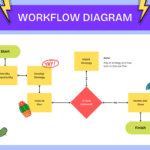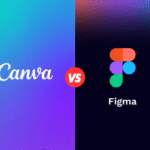Now Reading: Creator Spotlight Series: Canva’s Innovation
-
01
Creator Spotlight Series: Canva’s Innovation
Creator Spotlight Series: Canva’s Innovation

Creator Spotlight
The Creator Spotlight Series is an initiative designed to illuminate the stories of innovative entrepreneurs who have made a lasting impact in their respective fields. This series serves as a platform to delve into the lives and journeys of creative individuals, providing readers with valuable insights into their thought processes, challenges, and triumphs. In an increasingly competitive landscape, understanding the paths taken by successful creators can inspire budding entrepreneurs and established professionals alike.
Among these influential figures is Melanie Perkins, the co-founder and CEO of Canva, a design platform that has revolutionized the way individuals and businesses approach design. By highlighting figures like Perkins, the Creator Spotlight Series aims to explore the dynamics of creativity and entrepreneurship, showcasing not only their achievements but also the innovative thinking that drives their success. Perkins’ journey, marked by persistence and a visionary approach, serves as a testament to the power of creativity in problem-solving and innovation.
This series also emphasizes the significance of creativity in entrepreneurship. It is essential to highlight how creative thinking not only fuels innovation but also cultivates resilience in the face of challenges. Entrepreneurs are often required to navigate uncertainties, and those who harness their creative abilities tend to find unique solutions that set them apart in the marketplace. The stories shared in the Creator Spotlight Series will exemplify these traits, providing readers with firsthand knowledge of how creativity can lead to the transformation of ideas into successful ventures.
Through this series, readers will gain a deeper understanding of what it takes to foster creativity and leverage it for entrepreneurial success. By examining the journeys of remarkable individuals like Melanie Perkins, we aim to inspire others to embark on their creative endeavors and pursue their passions with vigor and determination.
Canva Founder
Melanie Perkins stands as a transformative figure in the realm of design and entrepreneurship, serving as an exemplary model of creativity and innovation. As the co-founder and CEO of Canva, Perkins has revolutionized the way individuals approach graphic design, particularly for those lacking formal training. Her entrepreneurial spirit is not only evident in her successful navigation of the startup landscape but also in her unwavering commitment to making design accessible to all. This core value aligns seamlessly with the broader themes of creativity and innovation that are central to this series.
One of the most compelling reasons to feature Melanie Perkins is her groundbreaking work with Canva. When she conceived the idea for the platform during her time as a university student, she recognized a gap in the market: many students struggled with design projects due to the complexity of existing software. This insight propelled her to create a user-friendly solution that allows people from various backgrounds to design effortlessly. Under her leadership, Canva has grown into a widely recognized design tool used by millions globally, demonstrating her ability to blend creativity with a keen understanding of consumer needs.
Furthermore, Perkins’ advocacy for inclusivity and empowerment within the design space is noteworthy. Her vision extends beyond just successful business metrics; she believes in creating an environment where creativity can flourish for everyone. This commitment significantly impacts users, encouraging them to express their ideas creatively without barriers. Perkins exemplifies a modern entrepreneur who balances innovative business practices with social responsibility, making her a compelling feature for discussions focused on creativity and the changing landscape of design accessibility.
A Compelling Story-Driven
Melanie Perkins, the co-founder and CEO of Canva, has a remarkable story that intertwines her passions for design and education. Raised in a suburb of Perth, Australia, she quickly demonstrated an interest in the creative arts, particularly drawing and design. Even as a child, Melanie was captivated by how design could communicate ideas and evoke emotions, which later became a foundation for her entrepreneurial journey.
Her academic path began at the University of Western Australia, where she pursued a degree in communications and design. Melanie’s experience teaching design programs to fellow students at her university marked a pivotal moment in her career. During these sessions, she recognized a significant barrier faced by students: existing design software was often overly complex, making it challenging for even the most passionate designers to create compelling work. This insight ignited her ambition to create an accessible platform that would empower anyone to engage in design without the steep learning curve typically associated with industry-standard tools.
In her early experiences, Melanie’s determination was paired with resilience. After pitching her idea for a simple, user-friendly design tool at multiple startup events, she faced numerous rejections. However, undeterred by the setbacks, she continued to refine her concept, demonstrating her unwavering commitment to her vision. Alongside her partner, Cliff Obrecht, she eventually secured seed funding, which paved the way for the launch of Canva in 2013. Their journey from a humble idea to a globally recognized design platform is a testament to Melanie’s dedication to democratizing design and educational resources.
Her story is not just about creating a successful business; it is also about her relentless pursuit of making design accessible to everyone. By fostering creativity and simplifying the design process, Melanie Perkins has transformed lives and continues to inspire a generation of budding entrepreneurs.
From Early Struggles to Success
The story of Canva’s inception is a testament to innovation born out of adversity. Melanie Perkins, an Australian entrepreneur, first encountered the challenge of teaching design to students who found graphic design software overwhelmingly complex. This experience inspired her initial venture, Fusion Books, which aimed to simplify the creation of school yearbooks. By enabling students and schools to design their yearbooks online, Perkins addressed a significant gap in the market while gathering valuable insights into the design needs of users.
Despite her early successes with Fusion Books, Melanie faced numerous obstacles that tested her resolve. The concept of an online design platform was unproven, and securing funding for her ambitious vision proved to be a daunting task. Perkins pitched her idea to various investors, oftentimes meeting skepticism due to the lack of a clear precedent. Nevertheless, her unwavering belief in her vision propelled her forward. She sought assistance from her co-founder, Cliff Obrecht, who played a crucial role in supporting and expanding Perkins’ initial ideas into something that had broader appeal. Together, they worked tirelessly to refine their concept and develop a prototype.
In 2012, Perkins, Obrecht, and a supportive team launched Canva, a user-friendly online design tool that democratized graphic design. By enabling anyone, regardless of their skills, to create visually appealing content, they positioned Canva as an accessible platform for businesses, marketers, educators, and individuals seeking design solutions. The platform’s continuous growth reflected its users’ needs, evolving features, and an expansive template library. Melanie Perkins’ journey from a design educator facing early challenges to a leading figure in the tech landscape embodies the spirit of perseverance and ingenuity. Today, Canva stands as a beacon of innovation, revolutionizing the design process for millions worldwide.
Inside Melanie’s Creative Workflow
Melanie Perkins has fundamentally redefined creativity through her unique workflow, which is entrenched in simplicity and a user-centered design philosophy. At the core of her approach lies a commitment to understanding the needs of users, allowing for a tailored experience that resonates with a broad audience. Perkins often emphasizes the importance of viewing every problem through the lens of the user, stating, “If you focus on solving real problems for people, the solutions become much clearer.” This perspective creates a framework where creativity is not just about generating ideas but about addressing specific challenges effectively.
Citing the significance of collaboration, Perkins believes that the collective creativity of her team acts as a catalyst for innovation. At Canva, diverse talents come together. She once remarked, “Great ideas can come from anywhere, and it’s essential to foster an environment where everyone feels empowered to contribute.” This open environment encourages team members to express their thoughts freely, thus generating a range of solutions that can be refined into actionable strategies. The combination of different perspectives is instrumental in driving creativity and helps shape a product that is not only functional but also delightful to use.
Moreover, Perkins employs iterative design in her workflow. This process involves continuous feedback loops, where prototypes undergo multiple refinements based on user testing and team input. “Iteration is key to success,” she has said, illustrating her belief that creativity thrives in cycles of testing and adaptation. This method allows for the incorporation of real user feedback which ultimately results in a product that closely aligns with user expectations and needs. It is through this methodical yet flexible approach that Perkins has been able to cultivate a creative workflow at the heart of Canva’s innovation.
Her Focus on Simplicity in Design
Melanie Perkins has always championed the concept of simplicity in design, believing that effective tools should be accessible to everyone, regardless of their design expertise. This philosophy has been a cornerstone of her approach to creating Canva, aiming to democratize design in a way that is both intuitive and user-friendly. By minimizing complexity in the design process, Perkins has allowed users to unleash their creativity without the usual hurdles associated with graphic design software.
The design interface at Canva reflects this commitment to simplicity. A noteworthy feature is its drag-and-drop functionality, which enables users to easily manipulate images, text, and other elements without requiring extensive training or prior experience. This eliminates the frustration often encountered with traditional design platforms that can overwhelm users with technical jargon and complicated menus. Instead, Canva focuses on providing a clear, straightforward user experience that encourages exploration and creativity.
Another significant aspect of Canva’s design philosophy is the use of templates. These carefully curated layouts serve as starting points for users to create their own materials, offering guidance while still allowing for personalization. For instance, individuals can select from a myriad of templates designed for social media graphics, presentations, and marketing materials, ensuring they have a solid foundation upon which to build. This element of simplicity not only enhances usability but also reduces the intimidation factor commonly associated with graphic design.
Ultimately, Melanie Perkins’ emphasis on simplicity is more than a design principle; it is a foundational element that empowers users to express themselves creatively. By streamlining the design process, Canva invites individuals from all backgrounds to engage in the creation of visually captivating content, which continues to redefine the boundaries of traditional design tools. This approach solidifies Canada’s mission to make design accessible and enjoyable for everyone.
User-Centered Design Process
User-centered design is a pivotal aspect of Canva’s innovation strategy, ensuring that the end product resonates deeply with its diverse user base. At its core, the user-centered design process prioritizes the needs, preferences, and limitations of users at every stage of product development. This approach is not merely an afterthought; it is ingrained in the foundational operations of Canva. By placing users at the forefront, the company is able to cultivate designs that are not only functional but also intuitive and engaging.
A key component of this design philosophy is the emphasis on user feedback. Canva actively solicits insights from its users through interviews, surveys, and usability tests, which serve to identify pain points and areas for improvement. This direct interaction with users allows Canva to iterate on designs in a manner that is responsive to real-world needs and behaviors. For instance, when users express difficulties in navigating the platform, designers analyze these comments and adjust their workflows to enhance user experience. Such a responsive approach allows Canva to evolve its offerings continually, ensuring relevance in a rapidly changing digital landscape.
Empathy is another crucial element woven into the fabric of Canva’s design process. Understanding user experiences fosters deeper connections between the product and its audience. Designers and developers at Canva engage in empathetic research, immersing themselves in user scenarios to appreciate their unique challenges and aspirations. This holistic understanding not only informs the design choices made but also instills a culture where innovations are aligned with user desires. Ultimately, the user-centered design process at Canva illustrates a commitment to creating tools that empower individuals to express their creativity effectively and effortlessly.
Collaborative Team Dynamics at Canva
The collaborative dynamics within Melanie Perkins’ team at Canva are instrumental to fostering innovation and creativity. At the core of this approach is a culture that encourages open communication and regular feedback among team members. Each individual contributes unique skills and perspectives, which collectively enhance the creative process. This synergy is vital in developing Canva’s user-friendly design tools and features, making them accessible to a broader audience.
One of the key elements of collaboration at Canva is the establishment of rituals that promote teamwork and shared goals. Daily stand-up meetings are held to ensure that everyone is aligned with the project objectives. This practice not only helps in tracking progress but also opens up avenues for team members to voice concerns and share insights. By addressing challenges collaboratively, the team creates an environment where innovative ideas can flourish.
The culture of feedback at Canva cannot be overstated. Team members are encouraged to provide constructive critiques on each other’s work, fostering an atmosphere of mutual respect and growth. This practice not only improves individual performance but also enhances the overall quality of the projects undertaken. It serves to remind the team that each contribution, no matter how small, is valued and plays a significant role in the collective output.
Additionally, Canva promotes cross-functional collaboration, allowing members from different departments to contribute their expertise. By breaking down silos, the team can capitalize on diverse skill sets, further enriching the creative process. This approach ensures that innovation is not limited to a single domain but is a shared responsibility that every member of the team embraces.
In essence, the collaborative dynamics within Melanie Perkins’ team at Canva are a reflection of a powerful culture that prioritizes creativity, innovation, and collective success. These practices not only enhance collaboration but also drive the company towards achieving its mission of empowering users to design with ease and confidence.
Inspiring Quotes
One of her most notable quotes centers around the willingness to embrace failure: “You can’t be afraid to fail. It’s the only way to learn and grow.” This sentiment emphasizes the importance of taking risks in the creative process and understanding that setbacks are essential for innovation. Perkins’ journey with Canva began from her own experiences with challenges in design, highlighting that personal obstacles can lead to groundbreaking ideas.
Another powerful quote from Perkins reflects on the essence of creativity: “Creativity isn’t just about what we see, but about what we can imagine.” This statement encapsulates the notion that creativity transcends mere aesthetic appeal; it is about envisioning possibilities that others may overlook. Perkins’ belief in the limitless potential of imagination has been instrumental in fostering a culture of innovation at Canva, encouraging teams to think outside conventional boundaries.
Perseverance is a recurring theme in Perkins’ messages. She once remarked, “Success is a product of persistence. Keep pushing through the difficult times.” This underscores her commitment to resilience in the face of adversity. Perkins’ unwavering determination serves as a testament to aspiring entrepreneurs, illustrating that persistence is crucial for turning innovative ideas into reality. Her insights inspire countless individuals to stay dedicated to their goals, regardless of the obstacles they may face.
These quotes not only reflect Melanie Perkins’ personal philosophy but also resonate with broader themes of creativity and innovation. By sharing her experiences and perspectives, she encourages others to embrace their creative journeys and persist through challenges, making her an inspiring figure in the world of design and entrepreneurship.
Tools That Empower
The tools utilized by a pioneering platform like Canva play a pivotal role in facilitating creativity and innovation. Melanie Perkins, as the co-founder of Canva, has harnessed a range of software and methodologies that not only streamline the design process but also significantly enhance user experience. Among these tools, collaboration software stands out as key; it allows team members to work simultaneously on projects, providing real-time feedback and fostering an environment of creativity.
Moreover, Canva’s use of cloud-based technology is instrumental in enabling accessibility. By storing files online, the platform ensures that users can create and edit designs from anywhere in the world, on any device. This flexibility is fundamental to achieving Canva’s mission of simplifying design, as it democratizes access to powerful design tools, inviting a broader audience to engage with creative endeavors. Additionally, integrated templates and design elements within the software provide users with a robust starting point, helping to stimulate creativity without the daunting context of a blank canvas.
Furthermore, the adoption of agile methodologies within the work culture of Canva’s team allows for iterative development, where feedback loops and rapid prototyping can be efficiently implemented. This process not only cultivates innovation but also aligns closely with the vision of continual improvement that Melanie Perkins espouses. By promoting such methodologies, the team not only enhances their workflow but also ensures that they remain responsive to the ever-changing needs of their user base.
The blend of collaborative tools and innovative methodologies employed by Canva empowers Melanie Perkins and her team to transform their creative vision into reality. These resources are integral for streamlining workflows and fostering a culture of creativity, ultimately redefining the landscape of design accessibility.























